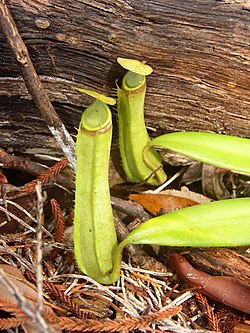Pitcher plant
A pitcher plant is a carnivorous plant (an insectivorous plant). Carnivorous plants are plants which eat insects and other small animals. Carnivorous plants grow in soil which has little nitrogen. All living things must have nitrogen. Carnivorous plants get their nitrogen from the insects they eat. They are adapted to areas with little nitrogen in the soil.
The pitcher of the pitcher plant is actually a modified leaf. The apex of the leaf is always the lid. Pitcher plants catch (get) insects in a cup of liquid. The walls of the cup make nectar (sweet liquid). The nectar attracts insects. When an insect lands on the wall, it falls down into the liquid.[1] The insect cannot get out of the cup because the walls are smooth and slippery and the walls have hairs pointing down.
After the insect is dead, its body rots. Rotting releases (lets loose) the nitrogen from the insect's body. The nitrogen then goes into the liquid and the plant takes in the nitrogen from the liquid.[2]
Pitcher Plant Media
Pitcher of Nepenthes distillatoria. A: Honey-glands from attractive surface of lid. B: Digestive fluid from interior of pitcher, in pocket-like depression of epidermis, opening downwards. C: Transverse section of the same.
Scanning electron micrograph inner surface of pitcher plant
References
- ↑ Moran J.A. & Clarke C.M. 2010. The carnivorous syndrome in Nepenthes pitcher plants: current state of knowledge and potential future directions. Plant Signal Behavior 5 (6): 644–8. [1]
- ↑ Pritchard et al. 2002. Evolutionary adaptations in pitcher plants. International Journal of Evolutionary Biology. 12 (3): 62–81.



